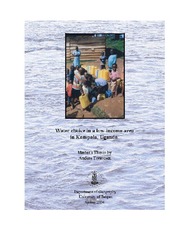Water choice in a low-income area in Kampala, Uganda
Master thesis
Permanent lenke
https://hdl.handle.net/1956/1446Utgivelsesdato
2004Metadata
Vis full innførselSamlinger
- Department of Geography [634]
Sammendrag
The intention of this study is to elaborate on important factors determining choice of water in a low-income area in Kampala, Uganda. The study area is located in a parish called Nateete, at the outskirts of the city. My approach includes both a questionnaire survey and in-depth interviews with people living within a defined geographical area. An important aim of the study is to link social practices to the water landscape. The latter is in this thesis understood as the physical water resources available to people in the geographical area under study. In my attempt to relate actions to the water landscape, I have employed a theoretical directioncalled the time-space perspective. Of special interest is this direction’s emphasis on how human action is influenced by various constraints. However, the understanding of watercollection practices is also sought in culturally embedded perceptions. In this thesis objective meaning of physical and social reality is not seen as pre given, but as a product of meaningful construction by interacting subjects. In this regard the influence of culture on both preference and perception of risk is elaborated. Among my respondents no one have a household connection to the piped water network. This implies that unless rainwater is collected from the roof, water has to be carried from the source to the dwelling. The study area is also characterised by having different water sources, with different characteristics available to people. Many of my respondents buy water from outdoor taps serving piped water. Nevertheless, the study shows that a large proportion still obtains water from traditional sources. Sadly, these are of questionable microbiological quality. Traditional sources are in this thesis understood as water sources where accumulated ground water can be fetched. The study illustrates the importance of distance to source on choice of water. The number of collectors decreases with distance from the source for all sources in the study area. The influence of the form and character of the water landscape has thus been indicated. However, the distance decay is not equal for all sources, making it necessary to focus on the characteristics of the water. Cost is one factor significantly influencing choice of water. Since water from traditional sources is free of charge (unless vendors who bring the water are employed), many overcome constraints in order to collect from these. Another factor hindering a transition from traditional to modern water sources seems to be culturally embedded perceptions in disfavour of piped water. Even though piped water is of good microbiological quality, there is a considerable dissatisfaction with this kind of water. Central in this thesis is it to explain why many prefer water from some traditional sources, even though these are of poorer microbiological quality compared to piped water. Much of the dissatisfaction with the latter seems to be related to the use of chlorine, affecting the taste and smell of water. There also seems to be a fear of visible contamination at times present in piped water. I assume the fear is related to the greater inability to predict when, and understand why, this contamination occurs. In comparison, visible contamination in traditional sources is closely related to rainfall. The emphasis of visual judgement of water is also believed to be an important reason for the lack of focus on the microbiological content of water in Nateete. In general, piped water seems mostly to be used when it is considered as the most convenient option. It is thus relatively little attention among my respondents to the improvements in microbiological quality that it offers. The main conclusion of this thesis is that the respondents seem to take into account the subjective, physical and social world in the process of choosing water source. It is thus not a question of whether structure or agency determine water-collection practices in Nateete, but rather of how these work together.
Utgiver
The University of BergenOpphavsrett
The authorCopyright the author. All rights reserved
